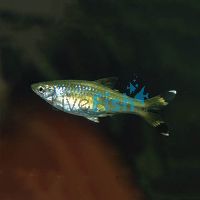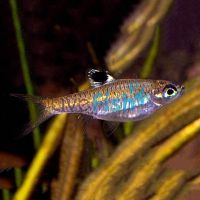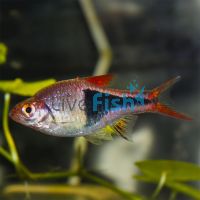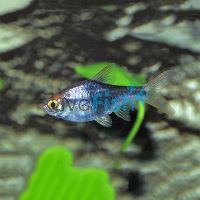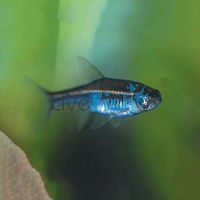Rasbora species vary slightly in size, but most reach a maximum size of around 4 cm (1.5”) and can live up to 6 or 7 years. They make perfect fish pets for a starter fish tank, as Rasboras are hardy and tolerant fish that should pose no major hurdles to your entry to the aquarist hobby.
Rasbora Care
Rasboras are a low maintenance small freshwater fish that can handle a variety of water parameters. They are not particularly susceptible to disease and should not cause any extra stress to their tankmates. They can be quite timid if introduced to tanks with overtly boisterous fish, so similarly placid species are recommended.
The real challenge with Rasboras lies in breeding, which is not recommended for beginners. Otherwise, this is an incredibly easy fish to raise and they make an excellent addition to community aquariums. Our most popular varieties are the Harlequin Rasbora, the Emerald Eyed Rasbora, Black Scissortail Rasboras and Blue Lined Rasboras are also very popular species.
Natural Habitat
Rasboras are native to tropical South East Asia, and can be found throughout Thailand, Malaysia and Singapore. They are quite commonly found in rivers, streams and forest swamps after flooding. They prefer shallow, slow-moving waters with plenty of overhanging vegetation.
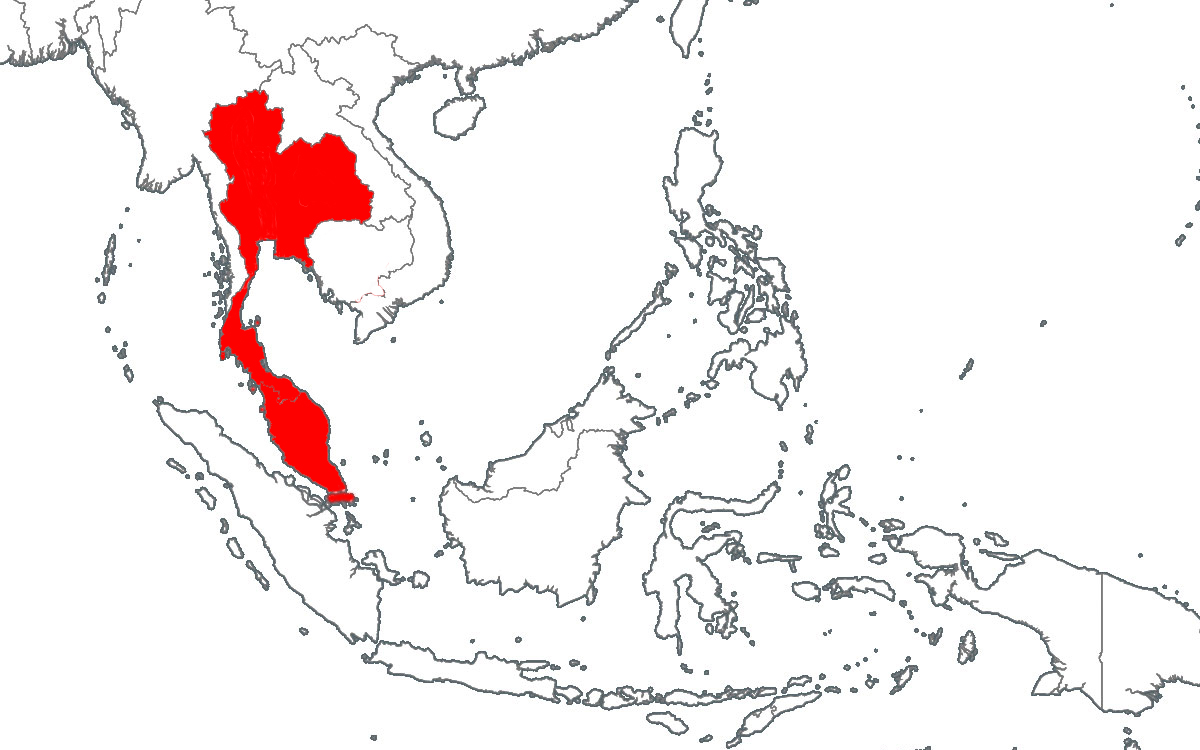
Behavior/Compatibility for Rasboras
Rasboras will spend most of their time in the mid-level open areas of your aquarium, so excessive sheltering will be a big clue that your Rasboras are experiencing stress. They are very peaceful fish that should not cause any problems for their tankmates, though boisterous and highly playful fish such as Clown Loaches will tend to stress them out. As a shoaling fish you will usually see them exploring the aquarium as a group. Although they are omnivores, Rasboras feature very small mouths and are subsequently one of the few species that can be paired with small freshwater shrimp safely. The only fish to really avoid pairing with are fairly obvious larger fish that are likely to view them as a meal like Oscars and other large Cichlids, some better species for tankmates include Barbs, Mollies, Guppies, small Gouramis and Danios.
Housing Rasboras and Aquarium Fish Tank Set-up Tips
Tank
These popular small aquarium fish require smaller tanks relative to their size, though bigger is obviously better for your fish’s wellbeing. With most species growing to the maximum size of around 4 cm (1.5”), a 38 litre (10 gallon) tank is sufficient, but will not provide a lot of room to grow your collection. Longer tanks are preferable to tall, though as rasboras are mid-water swimmers you should avoid overly shallow aquariums. Use subdued lighting and a tank lid as they have been known to jump. The below table begins with the minimum recommended amount of Rasboras, which is 5 in any given aquarium, as shoaling is a vital part of Rasbora happiness.
Recommended Max Fish Count Tank Volume 5-10 Rasboras 38 litres (10 gallons) 20 Rasboras 56 litres (15 gallons) 30 Rasboras 75 litres (20 gallons) 40 Rasboras 113 litres (30 gallons) Base
The type of substrate you prefer is not of huge consequence for your Rasboras, as they will rarely venture to the bottom of your aquarium. Feel free to select this based on the needs of the other fish in your community aquarium, aesthetics or ease of cleaning. If possible, you should opt for a darker substrate as rasboras prefer lower-light environments. This will also help to bring out the iridescent shimmer in their scales.
Foliage
Although your Rasboras should hopefully spend their lives out in the open, you should provide some cover even if it’s just to let them know it’s available in what they may perceive as an ‘emergency’. Driftwood and porous stones are fine for this, but plants such as Java moss or crested Java Fern are just some of the online aquarium supplies we have available here at our online aquarium store . Leave between 50 to 60 % of your water column clear to give your Rasboras room to explore.
Water
Rasboras can handle a varying range of water parameters, but as they hail from tropical waters, you should try to keep the temperature at around 22 to 25 degrees C (71.6 – 77 F). Depending on your local climate, a water heater to ensure the temperature stays within this range may be required in states with seasonal temperature variations like the ACT, Victoria and Tasmania.
Your pH should be of 6 - 8 and you should aim for a hardness of 5 - 15 DGH. To ensure your pH and hardness are within the correct ranges investing in a testing kit is recommended. Ensuring your water is properly filtered, and regularly changing the water (25% weekly or 50% every other week) is always recommended whichever species you are keeping and Rasboras are no exception to this.
You should also filter the substrate regularly and adjust the chemistry of any tap water you use to top your tank. One of our many water conditioning products. Is a great way to ensure that the water you add to your aquarium is always perfect for your aquarium fish.
Feeding and Care
Rasboras are not fussy eaters, but their relatively small mouths should always be taken into account when selecting their diet. As omnivores, you should offer them a range of meats and vegetables. Although they will rarely go to the surface during the course of the day, they will happily take floating flakes and pellets at feeding time. Beyond that, live insect larvae are ideal, along with bloodworms and daphnia. Vegetables such as blanched lettuce or spinach can also be incorporated. Rasboras should be fed twice a day, but never more than the amount they can finish within two minutes. Check out our range of tropical fish foods to find a good base diet for your Rasboras.
Great reasons to keep Rasboras in your tropical fish tank
- They are super easy to raise and make a great introductory species to the hobby.
- Rasboras require smaller tropical fish tanks and can be kept with a wide variety of other species.
- They can make a wonderful challenge for experienced breeders looking to hone their skills.
Check out our range of beautiful, healthy Rasboras from our online fish pet shop, and we will have them delivered direct to your door!
